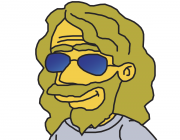Abstract:
Scarf et al. (Proc Natl Acad Sci 113(40):11272–11276, 2016) demonstrated that pigeons, as with baboons (Grainger et al. in Science 336(6078):245–248, 2012; Ziegler in Psychol Sci.
https://doi.org/10.1177/0956797612474322 , 2013), can be trained to display several behavioural hallmarks of human orthographic processing. But, Vokey and Jamieson (Psychol Sci 25(4):991–996, 2014) demonstrated that a standard, autoassociative neural network model of memory applied to pixel maps of the words and nonwords reproduces all of those results. In a subsequent report, Scarf et al. (Anim Cognit 20(5):999–1002, 2017) demonstrated that pigeons can reproduce one more marker of human orthographic processing: the ability to discriminate visually presented four-letter words from their mirror-reversed counterparts (e.g. ``LEFT'' vs. `` ''). The current report shows that the model of Vokey and Jamieson (2014) reproduces the results of Scarf et al. (2017) and reinforces the original argument: the recent results thought to support a conclusion of orthographic processing in pigeons and baboons are consistent with but do not force that conclusion.
Website


